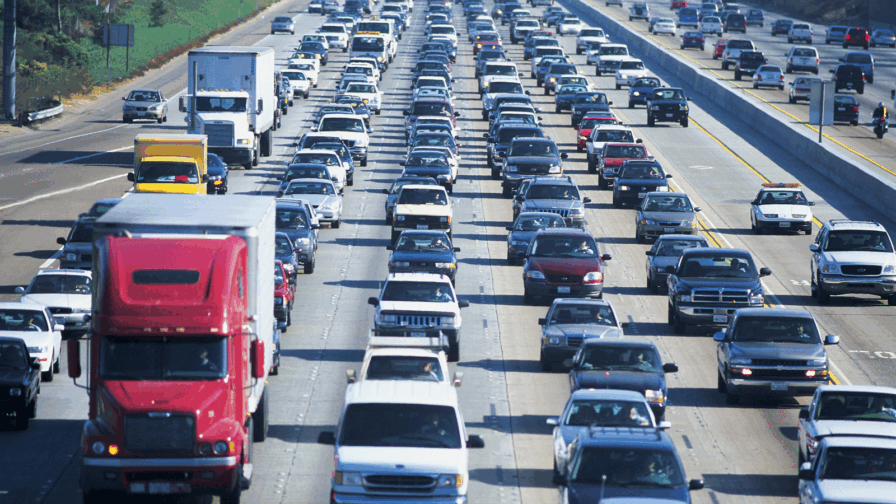Understanding Hours of Service Regulations for Commercial Truck Drivers

Understanding Hours of Service Regulations for Commercial Drivers
To ensure the safety of your commercial drivers as well as everyone else on the road, it’s essential to follow the Hours of Service (HOS) regulations put in place by the Federal Motor Carrier Safety Association (FMCSA).
HOS rules and regulations provide guidance for how long property-carrying and passenger-carrying drivers can be on the road. It also includes regulations on driver breaks, driving in adverse conditions, and more.
Read on to learn the ins and outs of HOS regulations for commercial drivers to ensure your team remains compliant.
What are the hours of service regulations for professional truck drivers?
The Hours of Service (HOS) regulations for professional truck drivers are a set of rules established by the Federal Motor Carrier Safety Administration (FMCSA) in the United States. These regulations specify how much time a commercial driver can spend on duty and behind the wheel, in order to reduce driver fatigue and fatigue-related accidents.
The newly revised hours of service rules went into effect on September 29, 2020, and include the following requirements:
-
- 11-Hour Driving Limit: A driver may drive a maximum of 11 hours after 10 consecutive hours off duty.
- 14-Hour Limit: A driver may not drive beyond the 14th consecutive hour after coming on duty, following 10 consecutive hours off duty. Off-duty time does not extend the 14-hour period.
- Rest Breaks: A driver must take a 30 consecutive minute break after 8 cumulative hours of driving without at least 30 consecutive minute breaks. Drivers should try and take their rest break after 5-6 hours of driving. Most ELD systems will look for the break after the driver has been driving for 4 or more hours.
- 60/70-Hour Limit: A driver may not drive after 60/70 hours on duty in 7/8 consecutive days. A driver can restart a 7/8 consecutive day period after taking 34 or more consecutive hours off duty, this is referred to as a 34-hour restart.
- Split Sleeper Berth Provision: Regulation 393.76 defines the specifics of what the FMCSA considers a sleeper berth. Typically, a truck with a day cab, a box truck, or a pickup, (even an extended cab), does not qualify even if the driver sleeps overnight in the truck. Drivers using a split sleeper berth provision may take a period of at least 7 consecutive hours in the sleeper berth and a period of at least 2 consecutive hours off-duty provided that, when the two periods are paired, they total at least 10 hours.
- 11-Hour Driving Limit: A driver may drive a maximum of 11 hours after 10 consecutive hours off duty.
- 14-Hour Limit: A driver may not drive beyond the 14th consecutive hour after coming on duty, following 10 consecutive hours off duty. Off-duty time does not extend the 14-hour period.
- Rest Breaks: A driver must take a 30 consecutive minute break after 8 cumulative hours of driving without at least 30 consecutive minute breaks. Drivers should try and take their rest break after 5-6 hours of driving. Most ELD systems will look for the break after the driver has been driving for 4 or more hours.
- 60/70-Hour Limit: A driver may not drive after 60/70 hours on duty in 7/8 consecutive days. A driver can restart a 7/8 consecutive day period after taking 34 or more consecutive hours off duty, this is referred to as a 34-hour restart.
- Split Sleeper Berth Provision: Regulation 393.76 defines the specifics of what the FMCSA considers a sleeper berth. Typically, a truck with a day cab, a box truck, or a pickup, (even an extended cab), does not qualify even if the driver sleeps overnight in the truck. Drivers using a split sleeper berth provision may take a period of at least 7 consecutive hours in the sleeper berth and a period of at least 2 consecutive hours off-duty provided that, when the two periods are paired, they total at least 10 hours.
Along with the general HOS regulations put in place by the FMCSA, there are multiple exceptions that some carriers can activate. Here are a few examples of common HOS exceptions:
-
- Short Haul: Short haul or local commercial drivers that drive within a 150-air-mile radius of the point of origin are exempt from FMCSA HOS rules. The short-haul exception in § 395.1(e)(1) allows a driver to use a time record in place of an electronic or paper RODS, provided the specific rule provisions are met. Even though these drivers are exempt, local commercial drivers often choose to use ELD to manage their HOS and see substantial increases in fleet visibility and efficiency.
- 16-Hour Rule: If you are a property-carrying CMV driver and usually come back to your work-reporting location and go home at the end of your workday, you might be able to use the 16-hour short-haul exception. This exception allows you to extend the 14-consecutive-hour driving window to 16 hours once every 7 consecutive days.
In order to use this exception, you must do the following:
• You must return to your work reporting location that day, as well as for your last 5 duty tours.
• You must be released from duty within 16 hours after coming on duty.
• You may use this exception only once every 7 consecutive days (unless you took 34 consecutive hours off to restart a 7/8-day period). - Agriculture: Agriculture transporters fall under the agriculture exemption category 49 CFR § 395.1(k). This exception provides an exemption from the HOS rule set for commercial drivers transporting agricultural commodities within a 150-air-mile radius circle from the source of the commodities. This exemption also applies to the transportation of farm supplies for agricultural purposes shipped from either a wholesale or retail distribution point to the location the supplies will be used or from a wholesale distribution point to a retailer. Once a driver crosses over the boundary leaving the 150-air-mile radius circle, the driver is subject to normal HOS rules. For livestock transporters, a second 150-air-mile radius circle from the destination of the livestock is allowed. This is why it is extremely important to operate with a geo-intelligent ELD to automatically manage the driver’s HOS clocks under the AG exemption.
- Personal Conveyance: Personal conveyance is the most commonly misused HOS exception. The FMCSA defines personal conveyance as “the movement of a commercial motor vehicle (CMV) for personal use while off duty.”
- Short Haul: Short haul or local commercial drivers that drive within a 150-air-mile radius of the point of origin are exempt from FMCSA HOS rules. The short-haul exception in § 395.1(e)(1) allows a driver to use a time record in place of an electronic or paper RODS, provided the specific rule provisions are met. Even though these drivers are exempt, local commercial drivers often choose to use ELD to manage their HOS and see substantial increases in fleet visibility and efficiency.
- 16-Hour Rule: If you are a property-carrying CMV driver and usually come back to your work-reporting location and go home at the end of your workday, you might be able to use the 16-hour short-haul exception. This exception allows you to extend the 14-consecutive-hour driving window to 16 hours once every 7 consecutive days.
In order to use this exception, you must do the following:
• You must return to your work reporting location that day, as well as for your last 5 duty tours.
• You must be released from duty within 16 hours after coming on duty.
• You may use this exception only once every 7 consecutive days (unless you took 34 consecutive hours off to restart a 7/8-day period). - Agriculture: Agriculture transporters fall under the agriculture exemption category 49 CFR § 395.1(k). This exception provides an exemption from the HOS rule set for commercial drivers transporting agricultural commodities within a 150-air-mile radius circle from the source of the commodities. This exemption also applies to the transportation of farm supplies for agricultural purposes shipped from either a wholesale or retail distribution point to the location the supplies will be used or from a wholesale distribution point to a retailer. Once a driver crosses over the boundary leaving the 150-air-mile radius circle, the driver is subject to normal HOS rules. For livestock transporters, a second 150-air-mile radius circle from the destination of the livestock is allowed. This is why it is extremely important to operate with a geo-intelligent ELD to automatically manage the driver’s HOS clocks under the AG exemption.
- Personal Conveyance: Personal conveyance is the most commonly misused HOS exception. The FMCSA defines personal conveyance as “the movement of a commercial motor vehicle (CMV) for personal use while off duty.”
Examples of the appropriate uses of a CMV while Off-duty for Personal Conveyance:
-
-
-
-
- Travel to a nearby restaurant or entertainment venue for personal reasons while off duty.
- Drive to a lodging facility after their workday has ended.
- Move their vehicle to a safe location during adverse weather conditions, such as a severe storm or hurricane.
- Commuting between the driver’s terminal and his or her residence, between trailer-drop lots and the driver’s residence, and between work sites and his or her residence. In these scenarios, the commuting distance combined with the release from work and start to work times must allow the driver enough time to obtain the required restorative rest to ensure the driver is not fatigued.
-
-
-
-
-
-
- Travel to a nearby restaurant or entertainment venue for personal reasons while off duty.
- Drive to a lodging facility after their workday has ended.
- Move their vehicle to a safe location during adverse weather conditions, such as a severe storm or hurricane.
- Commuting between the driver’s terminal and his or her residence, between trailer-drop lots and the driver’s residence, and between work sites and his or her residence. In these scenarios, the commuting distance combined with the release from work and start to work times must allow the driver enough time to obtain the required restorative rest to ensure the driver is not fatigued.
-
-
-
-
- Travel to a nearby restaurant or entertainment venue for personal reasons while off duty.
- Drive to a lodging facility after their workday has ended.
- Move their vehicle to a safe location during adverse weather conditions, such as a severe storm or hurricane.
- Commuting between the driver’s terminal and his or her residence, between trailer-drop lots and the driver’s residence, and between work sites and his or her residence. In these scenarios, the commuting distance combined with the release from work and start to work times must allow the driver enough time to obtain the required restorative rest to ensure the driver is not fatigued.
-
-
- Travel to a nearby restaurant or entertainment venue for personal reasons while off duty.
- Drive to a lodging facility after their workday has ended.
- Move their vehicle to a safe location during adverse weather conditions, such as a severe storm or hurricane.
- Commuting between the driver’s terminal and his or her residence, between trailer-drop lots and the driver’s residence, and between work sites and his or her residence. In these scenarios, the commuting distance combined with the release from work and start to work times must allow the driver enough time to obtain the required restorative rest to ensure the driver is not fatigued.
- Travel to a nearby restaurant or entertainment venue for personal reasons while off duty.
- Drive to a lodging facility after their workday has ended.
- Move their vehicle to a safe location during adverse weather conditions, such as a severe storm or hurricane.
- Commuting between the driver’s terminal and his or her residence, between trailer-drop lots and the driver’s residence, and between work sites and his or her residence. In these scenarios, the commuting distance combined with the release from work and start to work times must allow the driver enough time to obtain the required restorative rest to ensure the driver is not fatigued.
Examples of Uses of a CMV that Would Not Qualify as Personal Conveyance:
-
-
-
- The movement of a CMV in order to enhance the operational readiness of a motor carrier. For example, bypassing available resting locations in order to get closer to the next loading or unloading point or other scheduled motor carrier destination.
- Continuation of a CMV trip in interstate commerce in order to fulfill a business purpose, including bobtailing or operating with an empty trailer in order to retrieve another load or repositioning a CMV (tractor or trailer) at the direction of the motor carrier.
- Time spent transporting a CMV to a facility to have vehicle maintenance performed.
- Time spent traveling to a motor carrier’s terminal after loading or unloading from a shipper or a receiver.
-
-
-
-
- The movement of a CMV in order to enhance the operational readiness of a motor carrier. For example, bypassing available resting locations in order to get closer to the next loading or unloading point or other scheduled motor carrier destination.
- Continuation of a CMV trip in interstate commerce in order to fulfill a business purpose, including bobtailing or operating with an empty trailer in order to retrieve another load or repositioning a CMV (tractor or trailer) at the direction of the motor carrier.
- Time spent transporting a CMV to a facility to have vehicle maintenance performed.
- Time spent traveling to a motor carrier’s terminal after loading or unloading from a shipper or a receiver.
-
-
- The movement of a CMV in order to enhance the operational readiness of a motor carrier. For example, bypassing available resting locations in order to get closer to the next loading or unloading point or other scheduled motor carrier destination.
- Continuation of a CMV trip in interstate commerce in order to fulfill a business purpose, including bobtailing or operating with an empty trailer in order to retrieve another load or repositioning a CMV (tractor or trailer) at the direction of the motor carrier.
- Time spent transporting a CMV to a facility to have vehicle maintenance performed.
- Time spent traveling to a motor carrier’s terminal after loading or unloading from a shipper or a receiver.
- The movement of a CMV in order to enhance the operational readiness of a motor carrier. For example, bypassing available resting locations in order to get closer to the next loading or unloading point or other scheduled motor carrier destination.
- Continuation of a CMV trip in interstate commerce in order to fulfill a business purpose, including bobtailing or operating with an empty trailer in order to retrieve another load or repositioning a CMV (tractor or trailer) at the direction of the motor carrier.
- Time spent transporting a CMV to a facility to have vehicle maintenance performed.
- Time spent traveling to a motor carrier’s terminal after loading or unloading from a shipper or a receiver.
Who establishes hours of service regulations?
Hours of Service (HOS) regulations are established by the FMCSA – Federal Motor Carrier Safety Administration which is a federal agency within the United States Department of Transportation (DOT). The FMCSA’s primary mission is to reduce crashes, injuries, and fatalities involving large trucks and buses.
The FMCSA is responsible for developing and enforcing safety regulations for commercial motor carriers and drivers, including the Hours of Service (HOS) rules, enforcing the ELD mandate, commercial driver’s license (CDL) requirements, and drug and alcohol testing requirements. The agency also provides education and outreach programs to improve safety on the nation’s highways.
Why are hours of service regulations important?
Hours of service regulations are important for several reasons, the most important being the safety of all drivers on the roads. Preventing driver fatigue, reducing accidents, and promoting the health and well-being of the driver community are all reasons for the current HOS regulations.
By limiting the number of hours driven, FMCSA HOS rules and regulations decrease driver fatigue which is a significant factor in CMV-related accidents. HOS regulations also help to protect the overall health and well-being of commercial drivers by ensuring that they have adequate time for rest and recovery. This can help to reduce the risk of chronic health problems which are found to be associated with long hours of work and sleep deprivation.
Hours of services exceptions and penalties
It is important for commercial drivers and their employers to comply with these regulations to ensure the safety of themselves and other drivers on the road.
The most common HOS violations are:
- False logs – One of the reasons the ELD mandate was put into place was to reduce the ability to falsify logs. Credible electronic logging device providers make it more difficult for drivers to falsify logs.
- No ELD or record of duty status – Not using an ELD is not an option. The FMCSA and DOT are cracking down on the use of ELD and the use of AOBRD devices is no longer compliant.
- Unable to upload logs to web services – drivers are required to know how to send their electronic logs to the FMCSA web services at the roadside. This type of upload can be done directly from the driver’s ELD.
- Exceeding Daily HOS and driving windows – Drivers who exceed the daily HOS and driving windows are in violation of the HOS regulations.
- Exceeding Duty Cycle – Drivers who exceed the hours of the duty cycle are in violation of the HOS regulations.
- Failure to take a required break – Drivers are required to take a 30 consecutive minute break within 8 hours of driving status.
Failure to comply with the HOS regulations can result in serious penalties, including being declared out of service for 10 to 34 hours, fines, and license suspensions. Hours of service violation fines can range anywhere from $ 1,000 to $ 16,000.
FMCSA compliance can be confusing. Partnering with a technology provider to make compliance easy for your fleet administrators and drivers is extremely important to reduce driver violations, improve fleet efficiency, reduce potential driver fatigue, and increase overall driver safety.
Are you looking for a fleet solution to managing your HOS and fleet compliance? Contact us today!







